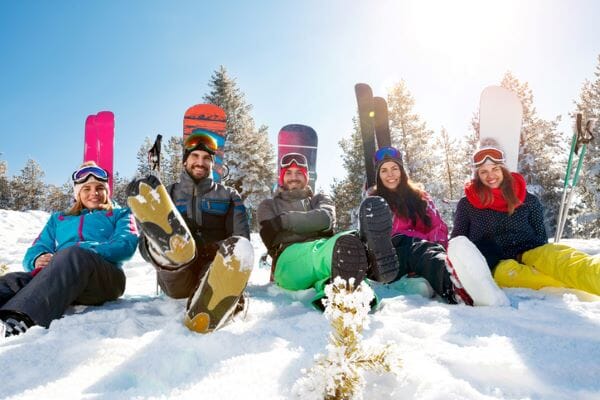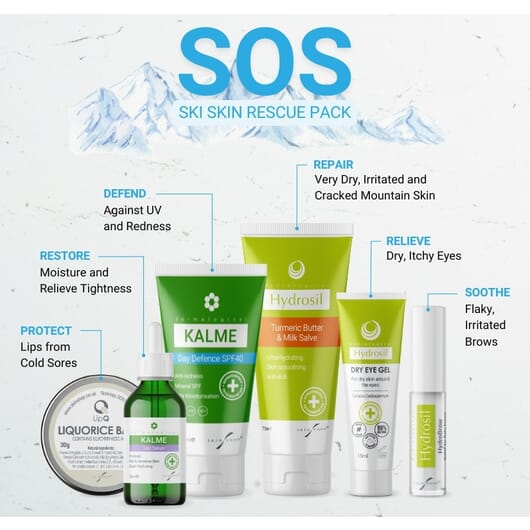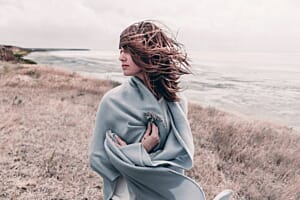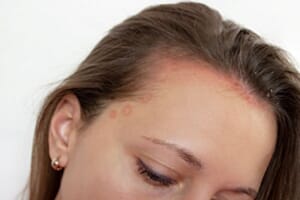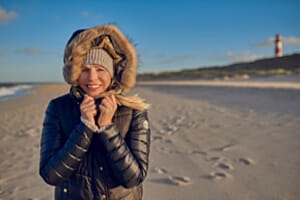Snowy and very and high-altitude cold mountain conditions can play havoc on sensitive skin conditions such as rosacea, eczema and cold sores due to exceptionally low air humidity, ultra drying indoor heating, strong snow reflecting UV rays and abrasive dry cold winds.
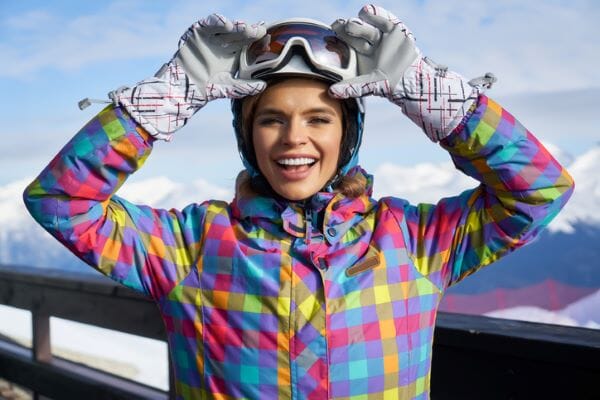
Dermatologist Dr Eva Melegh runs us through some of ways your ski holiday skin may get triggered and how best to deal with them.
Flaky Mountain Brows
Brows are often left quote exposed to the elements when skiing as they poke out above goggles and sunglasses. The cold dry air can quickly dehydrate brows and leave them flaky and itchy.
Ski Skin SOS
Avoid using barrier salves like Vaseline on exposed brows as this doesn’t address the underlying cause of itching and flaking. Repairing and replenishing brow barrier function is the key to keeping ski brows from dryness and flaking. Use a brow product with anti-inflammatory and prebiotic ingredients.
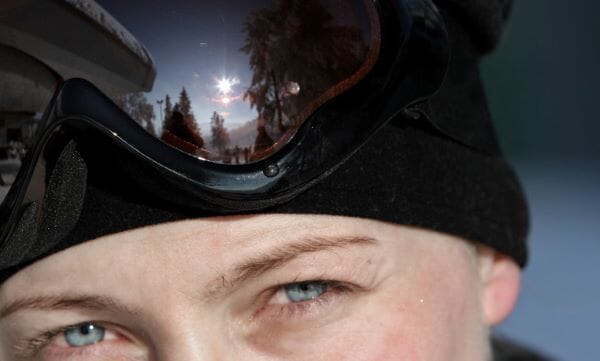
Temperature Transition Toll
Going from hot heated chalets and log fires and lunch time restaurants into cold snowy mountain conditions is one of the fasted ways to trigger a rosacea flare if you suffer from it and even you don’t, you can end up with a ruddy red complexion.
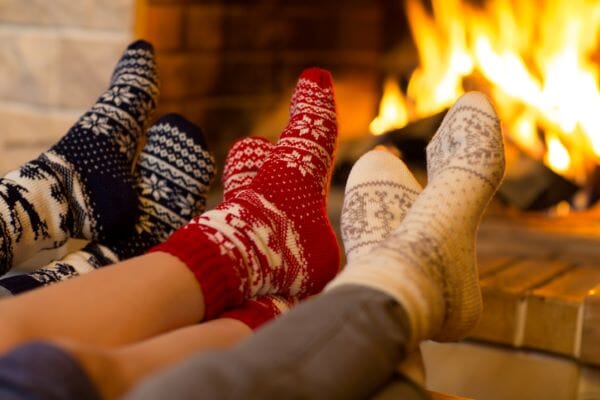
Ski Skin SOS
While not being able to stay at such a constant temperature during high-altitude winter weather is near on impossible, reducing the extremities of these temperature changes can help reduce the likelihood of triggering a red skin flare.
Showering in the morning rather than the evening can help as skin is acclimatised and warm from being in bed. Having a hot shower immediately after getting in from skiing is likely to cause the most extreme temperature change. Even waiting a few hours until your skin has acclimatised to indoor warmth before showering can help limit the suddenness of the temperature change.
Wearing a snood around the lower face when first heading out in the morning can also take the skin shock factor out of the temperature change.
Using skincare with anti-redness ingredients is very helpful for dampening red skin flares and keeping skin calmer.
Ruddy Rawness
As the temperature plunges you can find skin becoming more inflamed and spottier, especially if you suffer from rosacea.
It’s tempting when you see signs of acne starting to appear to start exfoliating more to try and scrub away the problem.
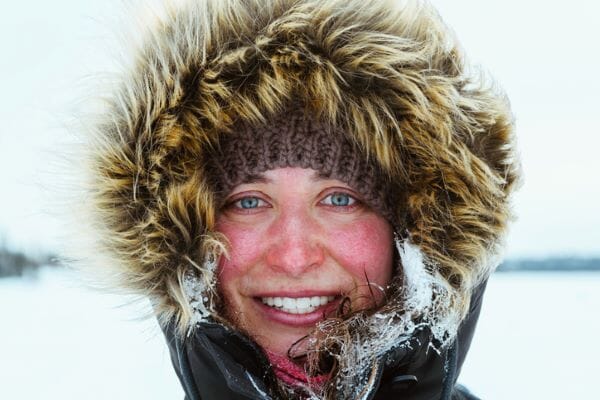
This is one of the worst things you can do during a ski holiday as your skin is likely to already be drier than normal and additional exfoliation can make things worse leaving you with ever drier and more sensitive skin.
Ski Skin SOS
The best thing to do on a ski holiday if you suffer from rosacea or dry and sensitive spotty skin is avoid exfoliating altogether.
Instead switch to a water-free cream cleanser with additional moistursing ingredients to clean your skin while you are skiiing.
Heavy Isn’t Helpful
Using a heavier based cream during skim holiday conditions to combat dryness may seem like a good idea but for sensitive and reactive skin it often make things worse as heavier creams tend to contain more complex ingredients which can trigger very sensitive skin.
Ski Skin SOS
Layering lighter products for extra moisture is better than switching to a heavier cream. Use serums that you can layer under your normal skincare products for additional moisturisation.
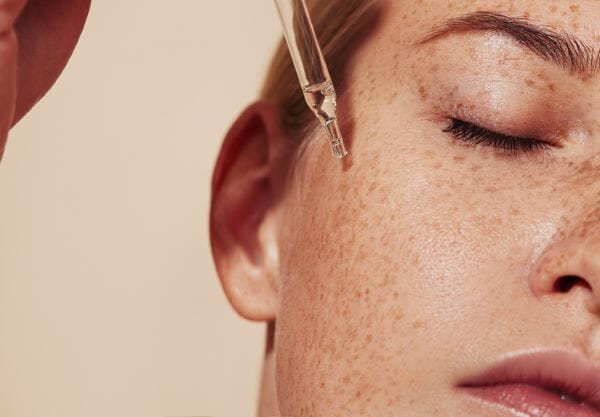
Layering a serum under your moisturiser and night cream can offer your skin additional moisturisation without over burdening it. If you suffer from a sensitive skin condition, it’s important to select a serum that specifically addresses your skin type and ones that contain skin barrier repairing ingredients such as prebiotics, can be especially beneficial for helping to replenish and repair a weakened winter skin barrier in skin conditions such as eczema and rosacea.
Exposed Extremities
Noses, chins and ears are the exposed extremities that can become very dry chaffed and sore from exposure to dry cold hash mountain conditions.
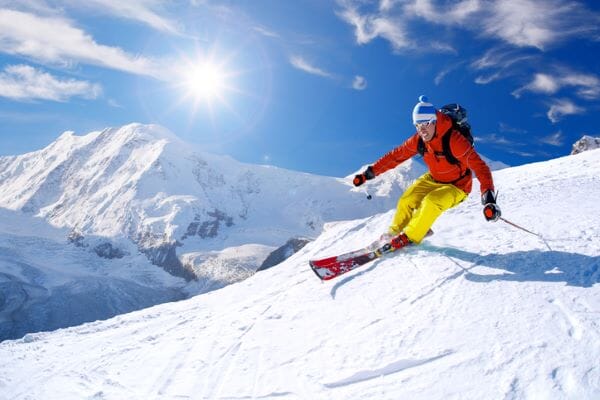
Ski Skin SOS
Salves are much more effective for these extremities than creams as they tend to stay put on the skin for longer. Ones which contain anti-inflammatory ingredients are especially beneficial.
Snowy Sun
Snow reflects UV light off it and can actually intensify the UV rays therefore SPFs in snowy high-altitude conditions are more important than ever.
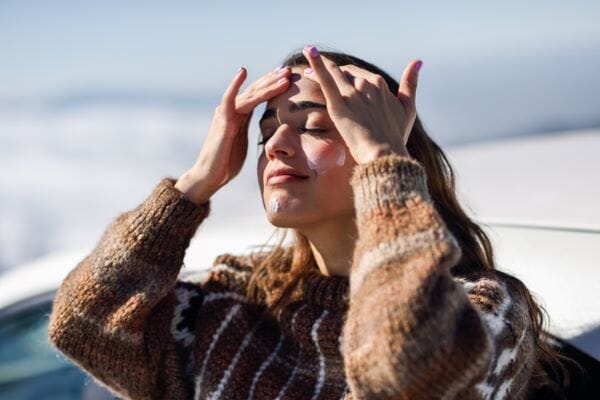
Ski Skin SOS
It’s crucial to wear a daily SPF of at least SPF40 while on ski holidays and make sure your SPF contains moisturising ingredients due to the high-altitude dryness.
For skin already prone to redness and sensitivity, a mineral SPF such as zinc oxide is more beneficial than a chemical filter as they are less reactive and more stable when exposed to high-altitude UV rays. Zinc oxide also has anti-inflammatory properties so is beneficial for reducing red and inflamed skin. SPFs with additional moisturisers are advantageous and if your ski SPF also contains anti-redness ingredients, then all the better.
Dry Mountain Eyes
The skin around the eyes is particularly vulnerable to dry, cold conditions as well as the dehydration from higher heating at night or higher altitudes. This delicate area can start to feel dry and irritated, both on the eyelids, around the crow’s feet area and in the brows, especially if you sometimes suffer from eye eczema or blepharitis.
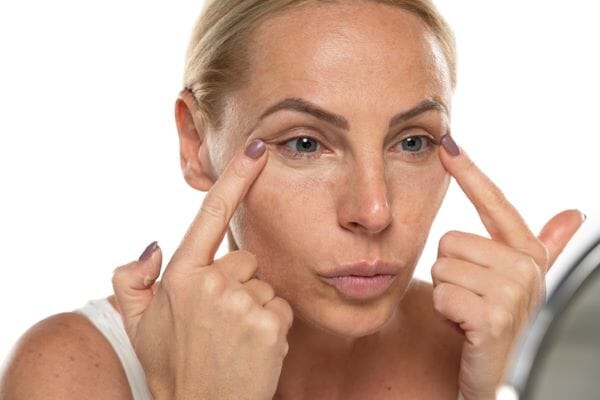
It can be logical to think about switching to a thicker more intensive eye product to try and counter the dryness. However, this can often lead to irritation and puffiness and if the skin around the eyes is already prone to sensitivity and inflammation then a heavier eye product can add to the puffiness.
Skin Skin SOS
The main issue with the skin around the eyes during cold wintry conditions is the itchiness and discomfort as the skin is more sensitive as opposed to being simply drier. Products that can deal with this is the solution to the problem rather than trying to use products that only address dryness. Lightweight Gels with anti-inflammatory action are more beneficial to dry winer eyes and can be worn during the day under SPF’s and at night under night creams.
Cracked Cold Lips
With high dry mountain winds outside and dry centrally heated environment insides, ski holidays are a time when lips get very dry and often chap or crack.
Even the smallest injury or abrasion to lips prone to cold sores significantly increases the risk of a cold sore outbreak.
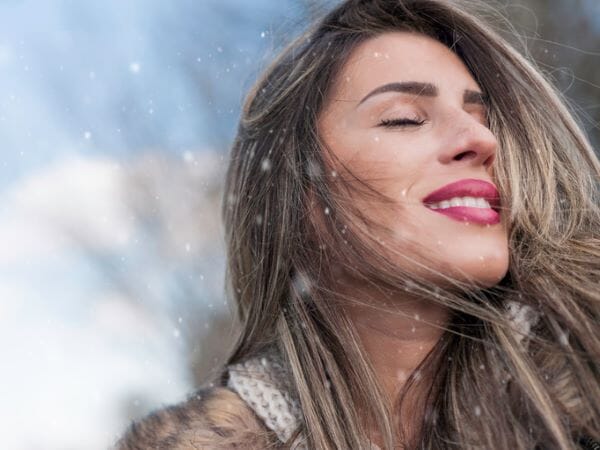
A sure sign that a cold sore is on its way is a tingling or itching feeling on your lip at the site the cold sore is going to appear about 2-3 days before a small hard lump begins to form at the site of the emerging cold sore.
Ski Skin SOS
Start drinking a lot of water and reduce drinking alcohol. Avoid hot drinks getting in contact with the lips and don't touch the lips.
Drink tepid Liquorice Tea and apply a cold sore preventing lip balm several times a day at the first warning signs of a cold sore. Use a clean dry finger to apply the balm and rinse your finger immediately afterwards.
This carefully selected customised Ski Skin Rescue Pack has been chosen to help your skin weather these ski season ski woes, and contains;
- Turmeric Butter & Milk Salve for immediate rescue and relief for very dry, irritated, chapped and cracked extremities. Contains anti-inflammtory tumeric and natural plant-derived steroid-mimicking ingredients to relieve itching and irritation plus hydrating and calming hypoallergenic donkey milk.
- Kalme Day Defence contains a pure micronized zinc pysical mineral sun block SPF40 with anti-redness ingredient and 24-hour moisturisation for protecting against UV damage, dryness and dampeninng redness and skin flares.
- Lip Q Lip Balm for protection against cold sores triggered by chapped and cracked cold snap lips. This 100% natural and odourless balm contains highly concentrated liquoice root extract and has been trialed by the Herpes Virus Association and proven to help prevent the frequency and intensity of cold sor outbreaks.
- Hydrosil Hydrobrow helps prevent and relieve dry flaky and irritated brows brought on by ultra cold weather conditions using brow barrier replenishing prebiotics.
- Hydrosil Dry Eye Gel gives instant relief from dry and itchy high-altitude eyes using natural plant-derived steroid-mimicking ingredients in light eye gel that can be worn under cosmetics, SPF creams and night creams.
- Kalme TeQ Serum contains ultra-hydrating and prebiotic skin barrier repairing agave exracts in an easily-absorbable perfume-free and chemeical-free serum with anti-redness action to prevent and relieve red and tight and sensitive apres ski skin.



